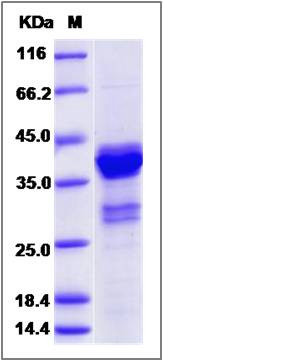Human MKI67 Protein (GST Tag)
KIA,MIB-,MIB-1,PPP1R105
- 100ug (NPP1650) Please inquiry
| Catalog Number | P13180-H09E |
|---|---|
| Organism Species | Human |
| Host | E. coli |
| Synonyms | KIA,MIB-,MIB-1,PPP1R105 |
| Molecular Weight | The recombinant human MKI67 /GST chimera consists of 354 amino acids and has a predicted molecular mass of 41 kDa. It migrates as an approximately 37-41 KDa band in SDS-PAGE under reducing conditions. |
| predicted N | Met |
| SDS-PAGE |  |
| Purity | > 80 % as determined by SDS-PAGE |
| Protein Construction | A DNA sequence encoding the mature form of human MKI67 (P46013-2) (Met1-Pro120) was fused with the GST tag at the N-terminus. |
| Bio-activity | |
| Research Area | Epigenetics |Cell cycle |Markers |
| Formulation | Lyophilized from sterile PBS, pH 7.4 1. Normally 5 % - 8 % trehalose, mannitol and 0.01% Tween80 are added as protectants before lyophilization. Specific concentrations are included in the hardcopy of COA. |
| Background | MKI67 contains 1 FHA domain and plays a key role in cell proliferation. During interphase, the MKI67 antigen can be exclusively detected within the cell nucleus, whereas in mitosis most of the protein is relocated to the surface of the chromosomes. MKI67 protein is present during all active phases of the cell cycle (G1, S, G2, and mitosis), but is absent from resting cells. MKI67 is an excellent marker to determine the growth fraction of a given cell population. The fraction of MKI67-positive tumor cells is often correlated with the clinical course of cancer. It is also associated with ribosomal RNA transcription. Inactivation of antigen MKI67 leads to inhibition of ribosomal RNA synthesis. |
| Reference |
